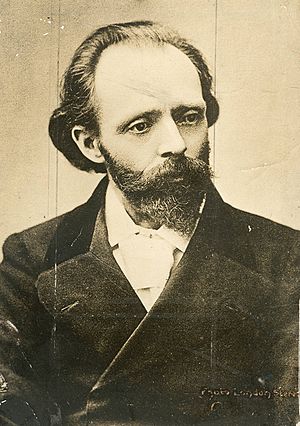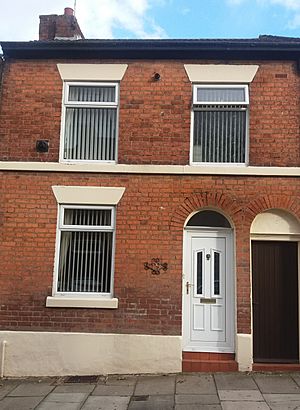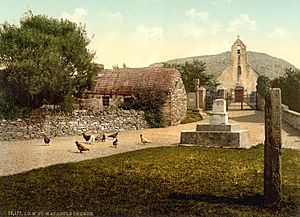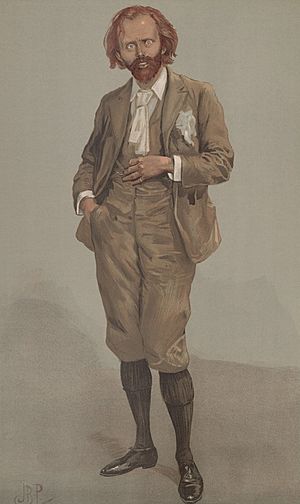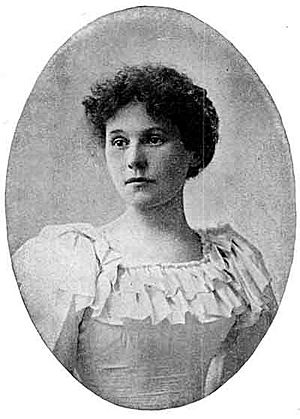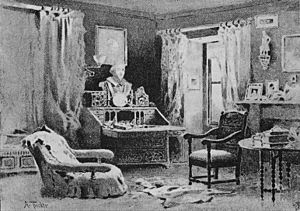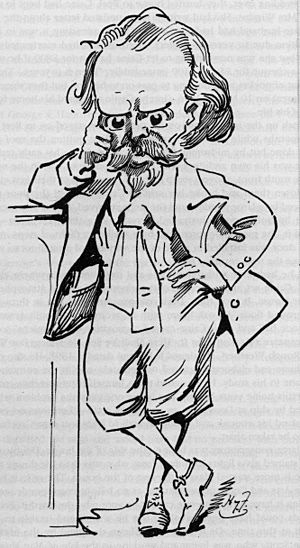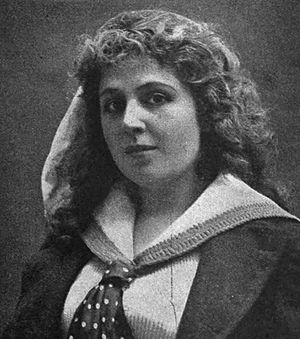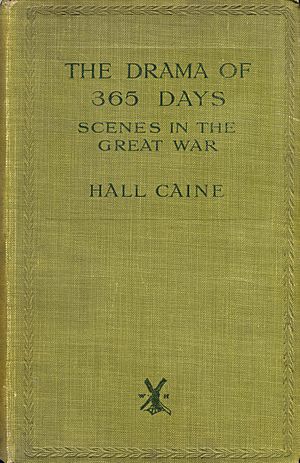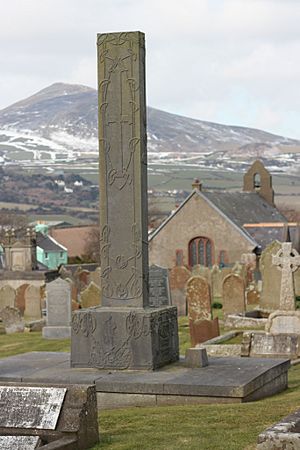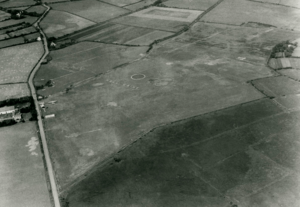Hall Caine facts for kids
Quick facts for kids
Hall Caine
|
|
|---|---|
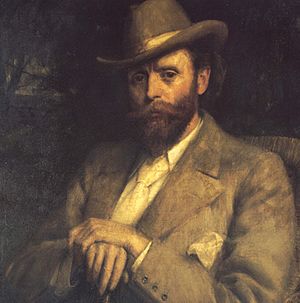
From a portrait by R E Morrison
|
|
| Born | Thomas Henry Hall Caine 14 May 1853 Runcorn, Cheshire, England |
| Died | 31 August 1931 (aged 78) Greeba Castle, Isle of Man |
| Resting place | Maughold, Isle of Man |
| Occupation | Writer |
| Period | Victorian, Edwardian |
| Literary movement | Romanticism, Realism |
| Spouse | Mary Chandler (m. 1886–his death 1931) |
| Children |
|
| Signature | |
 |
|
Sir Thomas Henry Hall Caine (14 May 1853 – 31 August 1931), known as Hall Caine, was a famous British writer. He wrote novels, plays, short stories, and poems. He was very popular in his time, selling ten million books. Caine was the highest-paid novelist of his era. His book The Eternal City was the first novel to sell over a million copies worldwide.
He also wrote many successful plays for London's West End and Broadway. He turned seven of his novels into plays. Most of his novels were also made into silent black and white movies. The Prodigal Son (1923) became the longest commercially made British film. Alfred Hitchcock's 1929 film The Manxman was his last silent movie.
Hall Caine was born in Runcorn, England. His father was from the Isle of Man, and his mother was from Cumbria. He grew up in Liverpool. After school, he trained as an architectural draughtsman. He spent childhood holidays on the Isle of Man with relatives. At 17, he worked there as a schoolmaster in Maughold. He later returned to Liverpool and became a journalist. He made friends with many important writers. Caine moved to London and lived with the poet Dante Gabriel Rossetti, working as his secretary. After publishing his Recollections of Rossetti in 1882, Caine started his writing career, which lasted for 40 years.
In 1895, Caine moved to the Isle of Man. From 1901 to 1908, he was a member of the Manx House of Keys, which is like their parliament. He worked for changes in the island's government. In 1929, he was given the Freedom of the Borough of Douglas, Isle of Man. He visited Russia in 1892 to help persecuted Jewish people. In 1895, he traveled to the United States and Canada. He helped authors get better international copyright agreements.
During World War I (1914–1918), Caine wrote many patriotic articles. He edited King Albert's Book, which raised money for Belgian refugees. In 1917, King Albert I of Belgium made him an Officer of the Order of Leopold. Caine canceled many writing contracts to help with the British war effort. In 1918, King George V made him a Knight of the British Empire for his work as a propagandist. In 1922, he became a Companion of Honour. Hall Caine died at his home, Greeba Castle, on the Isle of Man, when he was 78 years old.
Contents
Early Life and Influences
Childhood in Liverpool
Thomas Henry Hall Caine was born on 14 May 1853. He was the oldest of six children. His parents were John and Sarah Caine. His mother, Sarah, was a seamstress from Whitehaven, England. His father, John, was a blacksmith from the Isle of Man. At the time Caine was born, his father was working in Runcorn docks. A few months later, the family moved back to Liverpool. Caine spent his childhood and youth there. They lived in Toxteth, near Liverpool Docks, in a community of people from the Isle of Man.
As a child, Caine sometimes stayed with his grandmother and uncle in Ballaugh on the Isle of Man. His grandmother called him 'Hommy-Beg', which means 'Little Tommy' in Manx. She told him many stories about local myths and legends.
When Caine was nine, he lost two younger sisters to illness. He was sent to the Isle of Man to recover. He later used this experience in his novel The Bondman. Another sister, Lily Hall Caine, became a famous stage actress.
The Caine family belonged to the Baptist Church in Liverpool. Caine was a good speaker from a young age. He studied famous writers and developed his public speaking skills. From age ten, he went to Hope Street Unitarian Higher Grade School. He also took evening classes and spent many hours reading at Liverpool's Free Library. He loved to write, producing essays, poems, and stories.
Apprentice and Schoolmaster
At 15, Caine became an apprentice to an architect and surveyor in Liverpool. He met William Ewart Gladstone, who later became Prime Minister. Gladstone was impressed by Caine and offered him a job managing his estates, but Caine turned it down.
In 1870, Caine reconnected with his school friend, William Tirebuck. They tried to start a monthly magazine together.
Caine left his job due to health issues. He went to live with his uncle and aunt in Maughold on the Isle of Man. His uncle was the local schoolmaster and was ill. Caine became his assistant, teaching in the schoolhouse. He lived in a half-ruined cottage, which he repaired himself. He named it Phoenix Cottage.
His uncle encouraged him to write. Caine wrote articles for a local newspaper. He was also inspired by the writer John Ruskin to write about social issues. Caine became a frequent visitor to Ruskin's home. After his uncle died, Caine became the schoolmaster. He also helped local farmers with legal papers and letters. In March 1872, he returned to Liverpool.
Journalist and Theatre Critic
Back in Liverpool, Caine wrote articles about architecture. These were published in national newspapers and caught the attention of John Ruskin, who encouraged him. Caine also became a theatre critic for Liverpool newspapers, writing under the name 'Julian'. He loved Shakespeare and other playwrights. In 1872, he wrote his first play, The Charter, but it was not staged.
Caine joined friends to establish local branches of the Shakespeare Society. They held meetings where famous writers like John Ruskin, William Morris, and Dante Gabriel Rossetti contributed. In 1874, Caine wrote an enthusiastic review of Henry Irving's performance in Hamlet. This review was so good it was reprinted as a pamphlet.
His first short story, Max Wieland, was published around 1874. A year later, he became a dramatic critic for the Spectator. In 1876, his long poem, Geraldine, was published.
By 1875, Caine was often unwell. His brother John died from tuberculosis in 1877, and Caine also became very ill. He recovered, but his lungs were permanently damaged. He later wrote about tuberculosis in his novel The Woman Thou Gavest Me.
Caine joined a movement to protect Thirlmere in the Lake District from being dammed for a reservoir. This area was important to poets like William Wordsworth. Thirlmere later became the setting for his novel The Shadow of a Crime.
In 1878, Caine gave a lecture on Shakespeare. He received praise from famous writers like Matthew Arnold. He also met Bram Stoker, who later dedicated his novel Dracula to Caine.
Rossetti Years
Caine gave lectures on Dante Gabriel Rossetti's work and the Pre-Raphaelite Brotherhood movement. He sent a copy of his lecture to Rossetti, who was living as a recluse. Rossetti began writing to Caine, and they exchanged nearly 200 letters.
Caine's father was injured, so Caine took on the responsibility of supporting his family. In 1880, he wrote Stones Crying Out, a book about restoring old buildings. Rossetti introduced Caine to Ford Madox Brown, and they became friends. Caine even modeled for some of Brown's paintings. Caine and Rossetti finally met in September 1880.
Caine's health suffered from overwork. In 1881, he left his job to focus on writing. Rossetti became ill and asked Caine to live with him. Caine helped Rossetti and they spent time in Cumbria. While there, Caine heard a local myth that inspired his first novel, The Shadow of a Crime. Caine also helped arrange for Rossetti's painting Dante's Dream of the Death of Beatrice to be acquired by the Walker Art Gallery in Liverpool. In January 1882, Caine's poetry collection Sonnets of Three Centuries was published. Caine stayed with Rossetti until Rossetti's death in April 1882.
Start of Literary Career
From 1882, Caine wrote for the Liverpool Mercury. This allowed him to review plays in London. One review angered actor Wilson Barrett, who later encouraged Caine to write a play for him.
Caine's book Cobwebs of Criticism was published in 1883. It defended poets like Lord Byron and William Wordsworth from unfair reviews.
After Rossetti's death, Caine moved to London. He shared rooms with a friend, Eric Sutherland Robertson. They often had meals delivered by two young women, one of whom was 19-year-old Mary Chandler. Mary later married Caine. Mary had little education, so Caine paid for her to study for six months.
In late 1883, Caine and Mary went to the Isle of Wight. There, he wrote his first novel, The Shadow of a Crime. It was inspired by a Lake District legend. The book used the Cumbrian dialect he knew from childhood. It was published in February 1885 and made him famous. Mary started collecting scrapbooks about his public life.
Their son, Ralph Hall, was born in August 1884. The family moved to Bexleyheath, next door to William Morris's Red House. Caine had many friends in London's artistic circles. He often attended gatherings at the Lyceum Theatre, where he met the Prince of Wales.
In 1885, Caine's short novel She's All The World To Me was published in New York. It was his first novel set on the Isle of Man. He later used parts of this story in The Deemster.
His third novel, A Son of Hagar, was published in 1886. It was set in the Lake District and London. Caine started writing it with Robert Buchanan, but they stopped working together.
Mary and Caine secretly married in Scotland on 3 September 1886. Mary became a devoted wife, helping him with his work.
In 1886, two of Caine's sonnets were included in an anthology. In 1887, he wrote Life of Coleridge. In November 1887, The Deemster was published. It was set in the 18th-century Isle of Man. The book was very popular, selling over 50 editions in English and translated into many languages. Caine adapted it into a play called Ben-my-Chree, which opened in May 1888 and was very successful.
Middle Years
Travels and New Novels
Caine's novel The Bondman was published in 1890. It was a story of revenge and romance set in the Isle of Man and Iceland. Caine and Mary visited Iceland for research in 1889. The book sold almost half a million copies.
In 1888, Caine leased a cottage in Keswick. The next year, he bought a house called Hawthorns, overlooking Bassenthwaite Lake. He lived there for four years.
In 1890, Caine wrote Mahomet, a play about the life of Muhammad. The French government stopped a similar play by another author. Caine's play was also banned in Britain due to concerns about unrest among Muslim communities.
Caine traveled to Tangier, Morocco, in 1890 and 1891 to research for his novel The Scapegoat. He suffered from malarial fever there. In July 1891, The Little Manx Nation was published. It was based on lectures he gave about the history of the Isle of Man.
The Scapegoat was published in September 1891. It was set in Morocco and criticized anti-Semitic persecution. The book was praised by the Jewish community in London. Caine's second son, Derwent, was born in September 1891.
After The Scapegoat, Caine was asked to visit Russia to investigate the persecution of Jewish people. He funded the trip himself and carried letters of introduction from important people. He visited several Jewish communities but had to return due to a cholera outbreak. In 1893, he published three novellas in one volume, Cap'n Davey's Honeymoon.
Life on the Isle of Man
For his novel The Manxman, Caine rented Greeba Castle on the Isle of Man. This book, published in 1894, was very important because it helped end the system of three-volume novels. It tells the story of Pete, a fisherman, and Kate. The book sold nearly 400,000 copies in Britain and was translated into twelve languages. Caine bought Greeba Castle in 1896.
Caine wrote a guidebook called The Little Man Island for tourists in 1894. The Isle of Man was a popular holiday spot, and Caine's novels helped boost tourism. Tynwald Day, the island's national day, became more famous because of his books. Caine and Greeba Castle became a tourist attraction. In 1902, King Edward VII and Queen Alexandra visited the Isle of Man. They had read Caine's books and wanted to see the island. They enjoyed Caine's hospitality.
Copyright Work
Caine played a big role in Canadian copyright discussions in the 1890s. He represented the Society of Authors and helped negotiate new agreements. He traveled to New York and Canada in 1895, meeting with publishers and Canadian government leaders. He helped resolve disputes between Canadian publishers, the Canadian Copyright Association, and English authors.
Peak Years
The Christian and The Eternal City
Caine's novel The Christian was published in 1897. It was the first novel in Britain to sell over a million copies. It tells the story of Glory Quayle, a young actress, and John Storm, a priest. Caine adapted the book into a play, which was very popular. He directed the play in New York. Viola Allen produced it on stage in 1898, and it ran for 21 weeks.
Caine and his wife, Mary, spent four winters in Rome. There, Caine finished The Eternal City, his most successful book. It was published in 1901, selling over a million copies in English and translated into thirteen languages. The story is set in Rome in 1900. It's about David Rossi, a socialist, and his love story with Donna Roma Volonna. The play adaptation opened in London in 1902.
Household Words and The Prodigal Son
In 1901, Caine bought Household Words, a literary magazine started by Charles Dickens. He made his son Ralph the editor. Caine contributed many articles, including about Pope Leo XIII.
In 1903, Caine visited Iceland again for his novel The Prodigal Son. He even discovered a cave there, named "Hall's Hellin" (Hall's cave). The novel was published in 1904 and translated into thirteen languages. It is set in Iceland and tells the story of two brothers, Magnus and Oscar, and Oscar's wife, Thora. The book was also made into a play.
In 1906, Caine's play version of The Bondman was produced in London. It featured a sulphur mine explosion and volcano eruption. The production was very successful.
In 1908, Caine published My Story, an autobiographical book. It gave insights into his life and friends.
Egyptian Nationalism
Caine's novel The White Prophet was his literary response to the Denshawai Incident in Egypt in 1906. This incident involved a clash between British officers and Egyptian villagers. The book is set in Egypt and explores themes of nationalism. It was Caine's only book never to be reprinted, partly due to its support for Egyptian nationalism. Caine visited Egypt three times for research. He urged British officials to grant Egyptians their wish for independence. The book was serialized in The Strand Magazine and translated into seven languages. A play version was planned but banned due to political concerns.
|
Hall Caine
|
|
|---|---|
| Member of the House of Keys for Ramsey |
|
| In office 1901–1908 |
|
| Monarch | Edward VII |
| Lieutenant Governor | George Somerset, 3rd Baron Raglan |
| Succeeded by | William Crennell |
| Personal details | |
| Political party | Independent |
In 1910, Caine's new play, The Bishop's Son, based on The Deemster, opened in London.
Politics
On 24 October 1901, Caine was elected a Member of the House of Keys for Ramsey, Isle of Man. He was an independent politician. He ran for election after a bank collapse on the island left many people without money. He was re-elected in 1903.
Caine supported the Isle of Man having more control over its own government. He wanted a Manxman as Lieutenant-Governor and an elected Legislative Council. He was elected the first president of the Manx National Reform League in 1903. He chaired a committee that worked on constitutional reform.
Caine retired from politics in 1908. He had little time for it due to his writing. He had also been invited to stand for the British parliament but refused.
The Great War
When World War I started, Caine was 61. He was invited to join the War Propaganda Bureau to help promote Britain's interests. He signed a declaration stating that Britain was right to join the war. Caine gave up valuable literary contracts in America to focus on the British war effort.
Caine had the idea for King Albert's Book, published in 1914. It raised £20,000 for Belgian refugees. He invited many famous people to contribute, including Prime Minister Asquith and Winston Churchill. For his humanitarian aid, King Albert of Belgium made Caine an Officer of the Order of Leopold of Belgium in 1918.
Caine wrote many articles for English, American, and Italian newspapers. He believed his work helped bring Italy into the war on the side of the Allies. He also urged America to join the war. In 1915, his articles for The Daily Telegraph were published as a book, The Drama of 365 Days. He attended the memorial service for Nurse Edith Cavell, who saved soldiers' lives. In 1916, he was asked to work on creating the League of Nations. His Christmas book, Our Girls: Their Work for the War, published in 1916, celebrated women's contributions to the war effort.
In 1917, Caine was asked to write the screenplay for a propaganda film called Victory and Peace. The film was meant to show what would happen if Germany invaded Britain. Most of the film was destroyed in a fire, and it was never released.
Towards the end of 1917, Caine was offered a high honor for his war work. He chose to accept a knighthood and was known as 'Sir Hall'.
After the War
Caine's novel The Master of Man: The Story of a Sin was published in 1921. It tells the story of Bessie Collister and Victor Stowell. It sold 70,000 copies before it was even fully released. Caine announced it would be his last novel due to his age and health.
In 1923, Caine's last novel, The Woman of Knockaloe, was published. It showed his changed feelings from anti-German to supporting peace. The story is about a British woman who falls in love with a German prisoner of war. The setting is Knockaloe, a farm on the Isle of Man that became an internment camp during the war. Caine had suggested the camp's establishment.
On Armistice Day 1923, Caine made his first radio broadcast from the British Broadcasting Corporation. His last published work in his lifetime was a revised version of Recollections of Rossetti in 1928.
For the last eight years of his life, Caine worked on a Life of Christ. He visited Palestine and consulted theologians. He became ill, and the book was unfinished when he died. His sons published it posthumously in 1938 after extensive editing.
In 1922, Caine received the Order of the Companions of Honour for his contributions to literature. In 1929, he was granted the Freedom of Douglas for promoting the Isle of Man through his writing.
Films
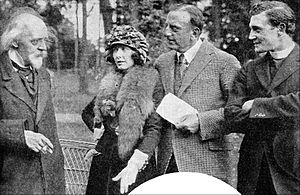
Most of Caine's novels were made into black-and-white silent films. The first film adaptation was The Christian (1911) in Australia. An unauthorized film of The Bondman (1916) was made by Fox Film Corporation in the United States.
The first authorized film of a Caine novel was The Christian (1914) in the United States. Caine wrote the film scenario himself, which was unusual for a famous author at the time.
The Christian (1915) was made by the London Film Company. Caine's son Derwent Hall Caine starred in it. The Manxman (1916) was filmed on the Isle of Man and was very popular. The Deemster (1917) was filmed in the United States. Caine was closely involved in its production.
Adolph Zukor's Famous Players Film Company produced The Eternal City (1915). It was filmed in London and Italy. Caine congratulated the producers after seeing the British premiere.
Caine wrote the screenplay for the propaganda film Victory and Peace (1918). The Woman Thou Gavest Me (1919) was also made into a film.
In the 1920s, Caine continued to be involved in film adaptations. He wrote the screenplay for Darby and Joan (1920). The fourth film of The Christian (1923) was made by Goldwyn Pictures. Caine helped with the filming on the Isle of Man and wrote the intertitles.
The Prodigal Son (1923) was the most expensive British film made at the time. Benito Mussolini appeared in The Eternal City (1923), but Caine disapproved of this adaptation.
Name the Man (1924) was based on The Master of Man. The Woman of Knockaloe was filmed as Barbed Wire in 1927. Alfred Hitchcock filmed The Manxman (1929) on the Isle of Man, but he and Caine did not get along well. The Manxman was Hitchcock's last silent film.
In the 1930s, plans to film The White Prophet were abandoned due to objections from film censors. Shortly before Caine's death in 1931, Metro Goldwyn Mayer bought the rights to The Christian to make a talking picture.
Personal Life
Caine was a short man with red-gold hair and a dark red beard. He often styled his beard to look like Shakespeare. He was often worried about his health, especially when he was overworked.
In 1912, Caine and Mary raised their granddaughter, Elin, who was their son Derwent's daughter. By 1922, Caine and Mary were informally separated but remained connected.
Hall Caine died on 31 August 1931, at his home, Greeba Castle, on the Isle of Man. He was 78. Messages of sympathy came from the Prime Minister and the King and Queen. His funeral was attended by sixty thousand Manx people and holidaymakers. He was buried in Kirk Maughold churchyard. A memorial service was also held in London. Mary Hall Caine died six months later and was buried next to him.
An Irish limestone monument with six characters from Caine's novels and a likeness of Mary marks their grave. It was designed by Archibald Knox. A statue of Hall Caine stands in Douglas.
Caine's Legacy
Hall Caine was incredibly popular during his lifetime. Crowds would gather to see him. However, today he is not as well known. Some reasons for this might be that his characters and plots can be similar, and his books often lack humor, being very serious.
Hall Caine Airport
Hall Caine Airport was an airfield near Ramsey, Isle of Man on the Isle of Man. It was named after Hall Caine by his sons, Gordon Hall Caine and Derwent Hall Caine. They wanted to associate the island's development with their father. The airport operated from 1935 to 1937, handling domestic flights. It closed mainly due to its location. The last commercial flight from Hall Caine Airport was on 2 October 1937.
Filmography
- 1911 – The Christian, directed by Franklyn Barrett in Australia.
- 1914 – The Christian, directed by Frederick A. Thomson in USA.
- 1915 – The Eternal City, directed by Hugh Ford and Edwin S. Porter in USA.
- 1915 – The Christian, directed by George Loane Tucker in UK.
- 1916 – The Bondman, directed by Edgar Lewis in USA.
- 1916 – The Manxman, directed by George Loane Tucker in UK.
- 1917 – The Deemster, directed by Howell Hansel in USA.
- 1917 – The Red Samson, based on The Bondman. Directed by Michael Curtiz in Hungary.
- 1918 – Victory and Peace, directed by Herbert Brenon in UK.
- 1919 – The Woman Thou Gavest Me, directed by Hugh Ford in USA.
- 1920 – Darby and Joan, directed by Percy Nash in GB.
- 1923 – The Christian, directed by Maurice Tourneur in USA.
- 1923 – The Prodigal Son, directed by A. E. Coleby in UK and Iceland.
- 1923 – The Eternal City, directed by George Fitzmaurice in USA.
- 1924 – Name the Man, based on The Master of Man: the Story of a Sin. Directed by Victor Sjöström in USA.
- 1927 – Barbed Wire, based on The Woman of Knockaloe, a Parable. Directed by Rowland V. Lee in USA.
- 1929 – The Bondman, directed by Herbert Wilcox in UK.
- 1929 – The Manxman, directed by Alfred Hitchcock in UK.
Images for kids


